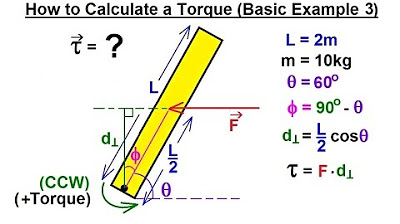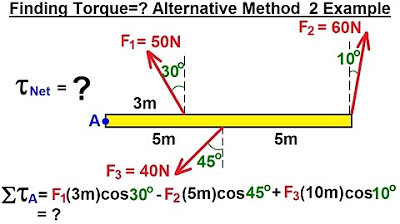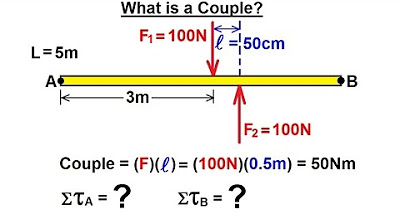Physics 15 Torque (11 of 27) Example 1: Forces=?
TLDRIn this lecture, a classic example of torque analysis is presented involving a beam connected to a wall at a height of four meters, with a length of five meters and touching the ground three meters away from the wall. Assuming no friction, a force of 240 Newtons acts to the right at the beam's base. The lecture demonstrates how to calculate the reactionary forces at the hinge using both a force triangle and torque analysis. The key takeaway is that the forces acting on the beam form a triangle, with the magnitudes of these forces being proportional to the triangle's dimensions. By applying this principle, it's determined that the force in the Y direction is 320 Newtons, and the net force on the beam is 400 Newtons. The lecture concludes by highlighting that both methods yield the same result, emphasizing the relationship between torque and triangular force summation in solving equilibrium problems.
Takeaways
- 📐 The problem involves a beam connected to a wall with a force applied at the bottom, creating a situation to analyze forces and torques.
- 🔵 The coefficient of friction between the floor and the beam is assumed to be zero, eliminating friction force from the analysis.
- ⚙️ A force of 240 Newtons is applied horizontally to the right at the base of the beam, which is 5 meters long and 4 meters high from the wall.
- 🔴 The forces acting on the beam are transferred to the hinge, causing the beam to push against the floor and against the hinge in both vertical and horizontal directions.
- 🔄 The sum of forces in the X and Y directions, as well as the sum of torques, must equal zero for the system to be in equilibrium.
- 📐 By drawing a triangle representing the forces, one can analyze the forces acting on the beam using geometric relationships.
- 📈 The magnitude of the forces in the triangle is proportional to the dimensions of the triangle, allowing for the calculation of unknown forces based on known ones.
- 🔢 Using ratios, the force in the Y direction (F_y) is calculated to be 320 Newtons by comparing the known force and distances.
- 🔀 The net force or sum of the forces at the hinge is determined to be 400 Newtons by using the ratio of the known force to the length of the beam.
- 🔩 The torque method is used to verify the force in the Y direction at the ground, which confirms the earlier calculation of 320 Newtons.
- 🔄 The analysis shows that the torque around a pivot point (point B) must sum to zero, which is used to solve for the unknown force in the Y direction at the ground.
- 📝 The script demonstrates two methodologies for solving the problem: using the triangular method and using torques, both yielding the same result.
Q & A
What is the height at which the beam is connected to the wall?
-The beam is connected to the wall at a height of four meters.
How long is the beam mentioned in the transcript?
-The beam is five meters long.
At what distance from the wall does the beam touch the ground?
-The beam touches the ground at a distance of three meters away from the wall.
What is the force applied at the bottom of the beam?
-A force of 240 Newtons is pushing to the right at the bottom of the beam.
What is the assumption made about the coefficient of friction between the floor and the beam?
-It is assumed that the coefficient of friction between the floor and the beam is equal to zero, meaning there is no friction force involved at the bottom.
How are the forces in the X and Y directions related to the equilibrium of the beam?
-In equilibrium, the sum of the forces in the X direction and the sum of the forces in the Y direction both add up to zero.
What is the method used to analyze the forces acting on the triangular shape formed by the beam and the forces?
-The method involves drawing a triangle and using the known force to assume the other forces, which are then resolved into components to find the reactionary forces at the hinge.
What is the force in the Y direction calculated to be?
-The force in the Y direction is calculated to be 320 Newtons.
How is the net force of the beam pushing against the hinge determined?
-The net force is determined by using the ratio of the force to the corresponding side of the triangle formed, which in this case is 240 Newtons relative to 3 meters equating to a force on the beam relative to 5 meters, resulting in 400 Newtons.
What principle is used to relate the magnitude of forces to the dimensions of the triangle formed by the beam and the forces?
-The principle used is that the magnitude of the forces must be proportional to the dimensions of the triangle, meaning the forces are relative to the lengths of the triangle's sides.
How does the torque methodology confirm the force in the Y direction at the ground?
-The torque methodology confirms the force in the Y direction at the ground by setting the sum of all torques relative to the pivot point (B) to zero, which results in the same value of 320 Newtons as calculated previously.
What is the significance of the triangular method in solving problems involving forces and torques?
-The triangular method helps to visualize and solve problems by establishing the relationship between the magnitude of forces and the lengths of the sides of the triangle, which is particularly useful when the forces can be represented in a triangular shape.
Outlines
🔍 Analyzing Torque and Forces on a Beam
This paragraph introduces a classic problem involving a beam connected to a wall at a height of four meters, with a length of five meters and touching the ground three meters away from the wall. The coefficient of friction is zero, and a force of 240 Newtons is applied horizontally to the right at the beam's bottom. The goal is to determine the reactionary forces at the hinge. The explanation involves the use of a triangle to represent the forces acting on the beam, leading to the conclusion that the forces must be proportional to the dimensions of the triangle formed by the beam, the wall, and the ground. The force in the Y direction (vertical force at the hinge) is calculated to be 320 Newtons, using the ratio of the applied force to the horizontal distance from the wall.
📐 Calculating Net Force and Torque Equilibrium
The second paragraph continues the analysis by determining the net force exerted by the beam on the hinge and vice versa. It uses the ratio of the force applied to the perpendicular distance from the wall to find the force on the beam, which is calculated to be 400 Newtons. The paragraph then introduces the concept of torque, with the pivot point (point B) being the hinge. It explains that the sum of all torques around this pivot point must equal zero for equilibrium. The torque caused by the 240 Newton force is calculated as a positive value, while the torque caused by the force in the Y direction is calculated as a negative value. By setting up an equation based on torques, the force in the Y direction at the ground is confirmed to be 320 Newtons, consistent with the previous calculation. The paragraph concludes by emphasizing the relationship between the magnitude of forces and the lengths of the triangle's sides in such problems.
Mindmap
Keywords
💡Torque
💡Beam
💡Coefficient of Friction
💡Force
💡Hinge
💡Equilibrium
💡Triangular Shape
💡Force Components
💡Ratio
💡Pivot Point
💡Newton's Third Law
Highlights
A classic example of torques is presented involving a beam connected to a wall and subjected to a force.
The beam is 5 meters long, connected at a height of 4 meters, and touches the ground 3 meters away from the wall.
Coefficient of friction between the floor and the beam is assumed to be zero, eliminating friction force.
A force of 240 Newtons is applied horizontally to the right at the bottom of the beam.
The forces acting on the beam are transferred, causing reactions at the floor and the hinge.
The sum of forces in the X and Y directions and the sum of torques must equal zero for equilibrium.
A triangular shape is drawn to analyze the forces acting on the beam.
The forces are proportional to the dimensions of the triangle formed by the beam and the ground.
240 Newtons is compared to 3 meters to find the force in the Y direction using ratios.
The force in the Y direction is calculated to be 320 Newtons.
The net force or sum of the forces at the hinge is determined using the ratio of forces to the beam's length.
The force on the beam is calculated to be 400 Newtons.
Torque analysis is used with a pivot point to confirm the force calculations.
The sum of torques around the pivot point must be zero in equilibrium.
Torque caused by the 240 Newton force and the force in the Y direction at the ground are considered.
The torque methodology confirms the force in the Y direction to be 320 Newtons, consistent with the triangular method.
The relationship between the magnitude of forces and the triangle's dimensions is emphasized for solving problems.
Both torque and triangular methods provide the same answer, validating the analysis.
Transcripts
Browse More Related Video

Torque Example #3: Leaning Ladder Problem

Physics 15 Torque (12 of 27) Example 2: Forces=? Tension=?

Ladder Example for Static Equilibrium

Physics 15 Torque Fundamentals (9 of 13) How to Calculate a Torque (Basic Example 3)

Physics 15 Torque (9 of 27) Alternative Method 1 & 2: Example Torque=?

Physics 15 Torque (6 of 27) What is a Couple?
5.0 / 5 (0 votes)
Thanks for rating: